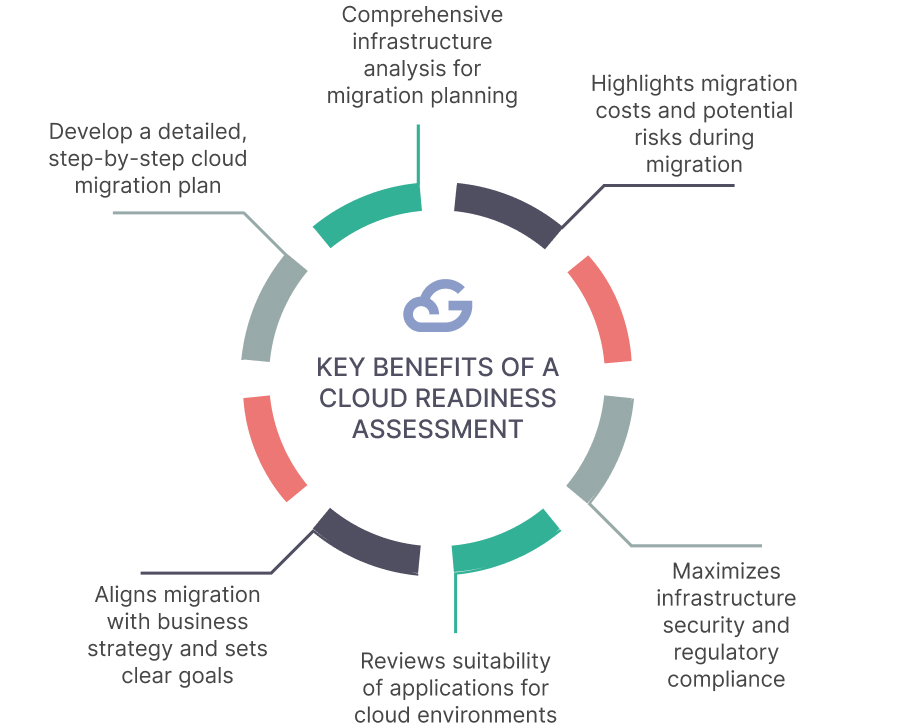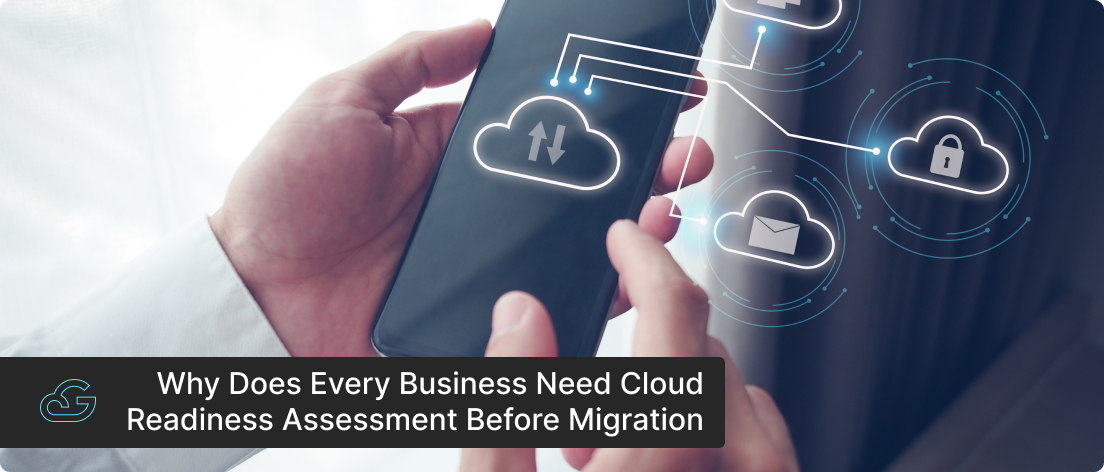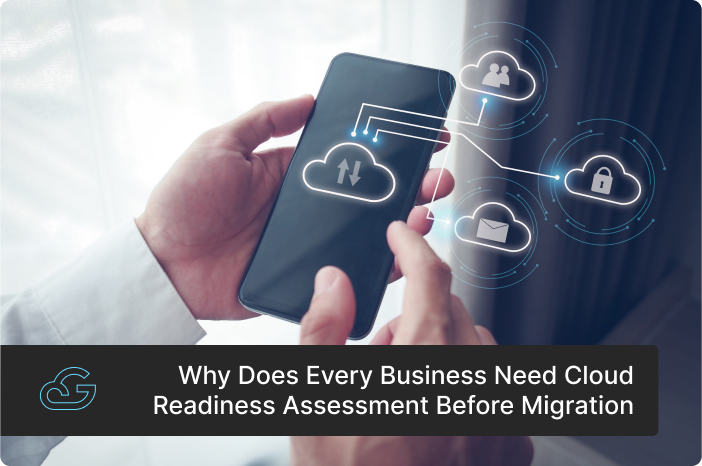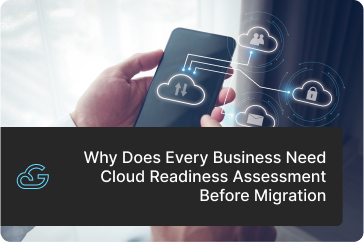Blogs / Cloud Migration
Why Does Every Business Need Cloud Readiness Assessment Before Migration
By
Vineeth
Posted: November 19, 2023
• 9 Min 20 Sec
Businesses are increasingly adopting cloud computing as a means to improve their efficiency, scalability, and flexibility. However, before a full-scale cloud migration, it is extremely important that you understand whether your organization is ready for it or not. You must carefully analyze if your existing IT infrastructure, workflows, applications, etc., are compatible with the cloud.
That’s where a Coud Readiness Assessment comes into the picture. With a cloud readiness assessment, you can ensure a seamless transition to the cloud while easily mitigating the risks that are associated with it. In this blog post, we will delve into the key details of cloud readiness assessment.
What is a Cloud Readiness Assessment?
A Cloud Readiness Assessment is a process used to evaluate an organization's preparedness for migrating to the cloud. It enables you to thoroughly examine the organization's current IT infrastructure, applications, data, processes, and all other elements that are being migrated to the cloud. With an assessment, you can, create a detailed roadmap for cloud migration, identifying potential challenges and developing strategies to mitigate any risks that might arise during this process. This helps ensure a smooth transition with minimal impact on business operations.
What are the Benefits of a Cloud Readiness Assessment for Your Business

A Cloud Readiness Assessment is essential for businesses considering migrating to the cloud. It offers several key benefits that ensure a successful transition. The main advantages include:
- Holistic View of IT Landscape:
- Identification of Costs and Risks:
- Infrastructure Security and Compliance:
- Application Architecture Review:
- Benchmarking Application Services:
- Cost Report for Cloud Migration:
- Organizational Preparedness:
- Analyzing Current System and Security:
- Defining Cloud Migration Goals and Strategy:
- Selection of Cloud Service Provider:
- Mapping Out Cloud Migration Plan:
The assessment provides a comprehensive overview of your IT environment, including your technology stack. This holistic understanding is crucial for planning an effective cloud migration strategy.
It helps identify the costs and potential risks associated with migration and adopting public cloud services. This information is vital for budgeting and risk mitigation strategies.
The assessment ensures that your infrastructure security and compliance are maximized, which is particularly important when handling sensitive data and adhering to regulatory standards.
A thorough review of your application architecture and lifecycle is conducted. This ensures that applications are suitable for cloud environments and can be modified if necessary.
The assessment includes a benchmark of existing application services, providing insights into performance and compatibility with cloud platforms.
You receive a detailed report on the costs of creating, migrating, and operating in a cloud environment. This helps in financial planning and resource allocation.
The assessment gives feedback on how well an organization is prepared for the change. It highlights areas of strength and those needing improvement, ensuring that the organization is ready for a successful cloud migration.
It involves a thorough analysis of the current system's performance, reliability, scalability, and security. Understanding these aspects is critical for identifying where cloud migration can offer significant benefits.
Organizations can ensure that the migration process aligns with their overall business strategy by establishing clear cloud migration goals and developing a strategy. This step is crucial for a successful transition to the cloud.
The assessment aids in choosing the right cloud service provider based on pricing, security, reliability, performance, and compliance requirements. This decision is fundamental to the success of cloud migration.
This includes creating a detailed migration plan outlining the process for migrating each application and data set to the cloud, ensuring a smooth and streamlined migration.
Do you know what a Cloud Maturity Assessment is?
- A Cloud Maturity Assessment helps organizations evaluate their current preparedness and capability in utilizing cloud computing technologies.
- It comprehensively analyzes various aspects, such as IT infrastructure, cloud readiness, strategic alignment, and operational processes.
- A cloud maturity model (CMM) helps you answer the question: “What should our journey to cloud and hybrid IT look like?” for both experienced cloud users and newbies to cloud use. Cloud Maturity Assessment is your road map to Cloud Maturity.
6 Important Steps for Cloud Readiness Assessment
The Cloud Readiness Assessment involves 6 key steps, and each step is crucial to ensure a seamless and secure transition to the cloud, tailored to the specific needs and capabilities of the business.
- Determine Migration Goals:
- Analyze Current IT Infrastructure:
- Determine the Budget:
- Choose the Cloud Server Type:
- Understand the Risks:
- Select a Strategy:
Set specific objectives for your cloud migration, such as reducing IT costs, improving data security, or maintaining a competitive edge. For example, a company might aim to cut IT expenses by 20% through cloud migration.
Assess your existing on-premise data centers to decide which applications are suitable for cloud migration and which should be retained or updated. For instance, an outdated application may need refactoring before moving to the cloud.
Estimate the initial investment and potential long-term savings of cloud migration using tools like cloud cost calculators. This could involve comparing the costs of on-premise servers versus cloud services.
Based on your objectives and IT assessment, decide whether a public, private, or hybrid cloud is most suitable. For instance, a business handling sensitive data might opt for a private cloud for enhanced security.
Prioritize security measures and disaster recovery plans to safeguard data in the cloud. This step might include implementing robust encryption and regular data backups.
Choose a migration strategy like 'lift and shift', refactoring, or replatforming, depending on how easily your IT infrastructure can transition to the cloud. For example, a 'lift and shift' approach might be used for applications that don't require any modifications for cloud compatibility.
What are Cloud Readiness Assessment Services?
Cloud Readiness Assessment Services are specialized evaluations that determine an organization's preparedness for adopting cloud computing. These services involve a comprehensive analysis of the existing IT infrastructure, a clear understanding of business objectives for moving to the cloud and identifying potential challenges and requirements. They include mapping applications and workloads to cloud services, documenting internal processes affected by cloud adoption, and developing a strategic plan to ensure a successful and efficient transition to the cloud environment.
What are the Advantages of Outsourcing Cloud Readiness Assessment Services?
Outsourcing a Cloud Readiness Assessment has several key advantages. These benefits collectively help businesses to optimize their cloud transition efficiently and cost-effectively.
- Cost Savings:
- Expertise and Skills:
- Documentation and Continuity:
- Access to Advanced Tools:
- Enhanced Security:
- Predictable Expenses:
- Improved IT Performance:
- Strategic IT Role:
- Future-Ready Solutions:
By outsourcing, businesses avoid the expenses associated with hiring and maintaining a specialized cloud team. For example, a small business could save on the high salaries required for cloud experts.
Outsourcing ensures access to diverse skills and cloud expertise, keeping businesses up-to-date with cloud technologies and methodologies. For instance, a company may leverage external expertise for complex cloud migrations.
Managed service providers offer comprehensive documentation and continuity, safeguarding against knowledge loss when internal IT staff change. This is crucial for maintaining consistency in IT operations.
By outsourcing, businesses gain access to advanced, enterprise-grade tools and technologies that might otherwise be out of reach due to cost or complexity.
Outsourcing to a managed cloud services provider helps you implement robust cybersecurity measures during cloud migration, which is essential in safeguarding you against cyber threats.
With fixed IT costs provided by outsourced services, companies can better plan their budgets, avoiding unexpected IT expenses.
Outsourcing leads to a well-managed and efficient IT environment, ensuring proactive support and maintenance.
Outsourced services help align IT operations with business strategies, enhancing overall business productivity and efficiency.
Outsourcing ensures businesses are equipped with innovative and growth-oriented solutions, keeping them competitive in a rapidly evolving marketplace.
Why Choose Gsoft for Cloud Readiness Assessment Services?
Gsoft Cloud offers Cloud Readiness Assessment Services to help organizations seamlessly transition to the cloud. Our services include a comprehensive review of systems and processes tailored to evaluate potential weaknesses or issues impacting cloud migration. Gsoft's team focuses on mapping applications and workloads to cloud services, identifying cloud-computing-related IT services, and assessing internal processes affected by cloud migration. This approach ensures organizations receive a detailed roadmap for successful cloud adoption, aligning IT services with business outcomes.
Conclusion:
A Cloud Readiness Assessment is an essential step for any business considering a move to the cloud. It comprehensively evaluates your current IT infrastructure, aligns your cloud strategy with business goals, and anticipates potential challenges. By conducting this assessment, you can ensure a smooth transition to the cloud, avoiding unexpected costs and performance issues. This strategic approach safeguards data security and compliance and maximizes cost efficiency and operational effectiveness, preparing your organization for a successful digital transformation.
Frequently Asked Questions (FAQs)
Q:
Why is a Cloud Readiness Assessment Necessary Before Migrating to the Cloud?
A Cloud Assessment is crucial for understanding and optimizing a business's cloud journey. It involves assessing workloads and performance in the IT environment, planning based on application interconnectivity, visualizing application integration categories, preparing for migration by prioritizing applications, and estimating the Total Cost of Ownership for on-premises vs. cloud applications. This process ensures readiness for cloud migration, addressing issues like skillset gaps, 'shadow IT', and integration complexities, ultimately guiding businesses towards effective and optimized cloud utilization.
Q:
Can a Cloud Readiness Assessment be performed in-house, or is external assistance necessary?
Yes and No. Performing a Cloud Readiness Assessment in-house or with external assistance depends on the organization's expertise and resources. The assessment thoroughly evaluates workloads, business objectives, technology stack, team capabilities, application dependencies, and security requirements. It requires expertise in cloud technologies and an understanding of the organization's unique IT environment. If in-house resources and expertise are insufficient, external assistance can provide valuable insights and ensure a comprehensive and effective assessment, aiding in a successful cloud migration.
Q:
Can a Cloud Readiness Assessment be customized based on an organization's specific needs?
Yes, a Cloud Readiness Assessment can certainly be customized to meet an organization's specific needs. This customization allows for a more focused and relevant evaluation, addressing unique business objectives, technology infrastructure, security requirements, and specific challenges or concerns. Tailoring the assessment ensures that recommendations and migration plans align closely with the organization's goals, operational needs, and resource constraints, thereby facilitating a more efficient and effective cloud migration strategy.
Q:
What key factors should be evaluated during a Cloud Readiness Assessment?
During a Cloud Readiness Assessment, key factors to evaluate include the current IT infrastructure's scalability, security posture, data governance policies, application architecture, and network capabilities. It's also important to assess the organization's technical expertise, cloud knowledge, and readiness for cultural changes associated with cloud adoption. This comprehensive evaluation helps understand the technical and organizational readiness for a smooth transition to cloud computing.
Q:
Can a Cloud Readiness Assessment help in identifying cost savings for an organization?
Yes, a Cloud Readiness Assessment can help identify potential cost savings by pinpointing areas where cloud solutions can optimize resource utilization, reduce infrastructure costs, and improve operational efficiencies. It aids in understanding the total cost of ownership (TCO) and return on investment (ROI) for cloud migration, allowing organizations to make informed decisions about their cloud investments and avoid unnecessary expenses.
Q:
How does a Cloud Readiness Assessment contribute to an organization's compliance and security posture?
A Cloud Readiness Assessment bolsters an organization's compliance and security posture by identifying specific compliance needs, analyzing security risks, and ensuring the cloud environment aligns with regulatory standards. This process involves tailoring security strategies, ensuring robust data governance, and continuously managing compliance and security in the cloud. It also includes evaluating third-party cloud service providers to maintain overall compliance and security standards, facilitating a secure cloud transition.
Q:
What role do stakeholders play in a Cloud Readiness Assessment?
Stakeholders such as Executive leadership, IT department heads, and managers, cybersecurity team, departmental managers, legal and compliance officers, end-users, external consultants, or partners play a critical role in a Cloud Readiness Assessment by providing insights into different aspects of the organization's operations, goals, and challenges. Their involvement ensures that the assessment aligns with the business objectives, addresses specific departmental needs, and considers various perspectives, leading to a more holistic and effective cloud migration strategy.
Q:
How does a Cloud Readiness Assessment impact the choice of cloud service providers and platforms?
A Cloud Readiness Assessment impacts the choice of cloud service providers and platforms by identifying specific requirements and preferences of the organization. It helps evaluate different cloud solutions, compare their features, costs, and capabilities, and determine the best fit for the organization's unique needs and objectives. This tailored approach ensures that the chosen cloud services align with the technical and business aspects of the organization.


Get Know More About Our Services and Products
Reach to us if you have any queries on any of our products or Services.











